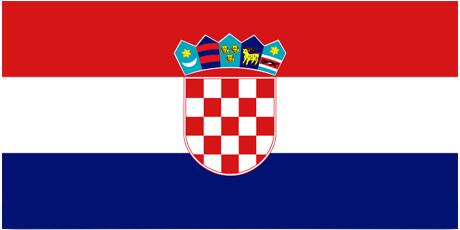Croatia Flag and Meaning
Flag of Croatia

Croatia Flag Meaning
The colors of the Croatian flag are the traditional Pan-Slavic colors, but are also a representation of the former Red Croatia with the red color, white for the White Croatia and blue for Slavonia. In the center of the flag is the image of the Croatian coat of arms.
There have been different variants of the flag, but it is a descendant of the tricolor that the Kingdom of Croatia used during the Empire of Austria in 1848. The colors of the flag were taken from the colors used by the Croats of the Kingdom of Croatia, the Kingdom of Slavonia and the Kingdom of Dalmatia in their bicolors. The current appearance was adopted on December 21, 1990. The flag also contained the coat of arms, which then had three coats of arms representing the three kingdoms.
Croatia Overview
| Population | 4.7 million |
| Currency | Croatian kunas |
| Area | 56.540 km² |
| Capital city | Zagreb |
| Population density | 83.1 residents/km² |
| HDI location | 51 |
Croatia shares borders with Slovenia and Hungary in the north, with Serbia in the east and has a coastline in the south and west at 1,778 km along the Adriatic Sea, the Dalmatian coast with numerous ports and spas. The territory is divided into 3 different regions: the mountains near Zagreb in the north; the rocky Adriatic coast; and the valleys of the central part of the country at Panonia. The mountain range on the coast consists of the Dinaric Alps, the Valebit mountain range and Velika Kapela, with altitudes of 700-2,200 meters. The valleys of the inner parts of Croatia are supplied with water by the Sava River, which runs through the country from the northwest to the southeast and forms a border with Bosnia and Herzegovina. The Drava River originates in the north, forming the border with Hungary and runs out into the Danube separating Serbia from Croatia. The Panonia Valley is affected by the air masses from the continent; the area is colder and less rainy than the coastal areas. The Dalmatian coast has a Mediterranean climate, with average temperatures in winter of 4 degrees and with up to 24 degrees in summer. The traditional economy is based on agriculture and cattle breeding. After World War II, lighter industries were founded and found by rich deposits of oil changed the country’s economic profile. The authorities are currently busy rebuilding the production apparatus and the vast areas that were devastated during the conflict, while at the same time assessing the environmental damage that is one of the results of the civil war.
People: Croats, 78.1%; Serbs, 12.1%; Muslims 1%; Hungarians, 0.5%; Slovenes, 0.5%; Checks, Italians and Gypsies.
Religion: Catholics, 76%; Greek Orthodox, 11%; Muslims, 1%.
Language: Croatian is the official language. Furthermore: Istrian, Roma, Hungarian, Czech, Slovenian and Italian.
Political parties: The Croatian Bloc (HB); The Croatian Democratic Union (HDZ), center-right party; The Croatian Christian-Democratic Union (HKDU); The Croatian Peasant Party (HSS); Party of Croatian Rights (HSP).
Social organizations: The Association of Independent Trade Unions in Croatia; Union of Autonomous Trade Unions in Croatia; The Railway Workers’ Union; The Metal Workers’ Union; Association of Croatian Journalists.
Official name: Republika Hrvatska.
Administrative subdivision: 102 districts.
Capital: Zagreb, 804,200 residents (2008).
Other important cities: Split, 200,800 residents; Rijeka, 180,000 in (2000)
Government: Kolinda Grabar-Kitarović, President since February 2015. Andrej Plenković, Prime Minister since October 2016. Parliament, Sabor, is one of the oldest in Europe. It has 152 members. Elections every 4 years.
National Day: June 25, 1991, Independence Day.
Armed forces: 105,000 men. (1995)
Paramilitary forces: 24,000 men from police; This includes 1,000 men stationed in Bosnia.













































